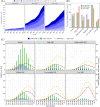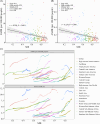Global burden of metabolic dysfunction-associated steatotic liver disease attributable to high fasting plasma glucose in 204 countries and territories from 1990 to 2021
- PMID: 39333707
- PMCID: PMC11437073
- DOI: 10.1038/s41598-024-72795-0
Global burden of metabolic dysfunction-associated steatotic liver disease attributable to high fasting plasma glucose in 204 countries and territories from 1990 to 2021
Erratum in
-
Author Correction: Global burden of metabolic dysfunction-associated steatotic liver disease attributable to high fasting plasma glucose in 204 countries and territories from 1990 to 2021.Sci Rep. 2024 Nov 25;14(1):29230. doi: 10.1038/s41598-024-80624-7. Sci Rep. 2024. PMID: 39587275 Free PMC article. No abstract available.
Abstract
Metabolic dysfunction-associated steatotic liver disease (MASLD) brings heavy clinical and economic burdens to patients worldwide. High fasting plasma glucose (HFPG) was proven to be an important modifiable risk factor. However, the global burden distribution of HFPG-attributable MASLD has not been fully studied. This study aimed to describe the epidemiological distribution and trends of the burden of HFPG-attributable MASLD worldwide. The data source was the 2021 Global Burden of Disease Study. Descriptive statistics were mainly conducted using disability-adjusted life years (DALYs) and deaths of HFPG-attributable MASLD from 1990 to 2021, as well as their age-standardized rates (ASRs) and population-attributable fractions. Subgroup analyses were conducted by region, age group, and sex. We found that 213.48 thousand DALYs and 10.02 thousand deaths in MASLD were attributable to HFPG worldwide in 2021, with an increase of 2.96 and 3.32 times compared with 1990, respectively. Over the past 32 years, age-standardized DALY rates (ASDRs) have fluctuated upward, reaching 2.45 per 100,000 people in 2021, with an increase of 81.21%. The ASDRs continued to rise in low, low-middle, and high social demographic index (SDI) regions, fluctuated upward at high levels in middle SDI regions, and were relatively low in high-middle SDI regions. People aged 50-69 accounted for the largest proportion of DALYs, while people over 70 had the largest increase of 3.73 times. Men had higher ASDRs, and the sex difference has been gradually expanding over the past 32 years, peaking at the age of 45-49. In conclusion, the burden of HFPG-attributable MASLD has continued to increase globally, with differences in geographical area, age, and sex distribution. HFPG, as a modifiable risk factor, should be given more importance. The implementation of targeted health intervention strategies is recommended for each country based on trends in the burden of HFPG-attributable MASLD.
Keywords: Disability-adjusted life years; Ecological study; Global burden of disease; High fasting plasma glucose; Metabolic dysfunction-associated steatotic liver disease; Non-alcoholic fatty liver disease.
© 2024. The Author(s).
Conflict of interest statement
The authors declare no competing interests.
Figures





References
-
- Rinella, M. E. et al. A multisociety Delphi consensus statement on new fatty liver disease nomenclature. J. Hepatol.79, 1542–1556. 10.1016/j.jhep.2023.06.003 (2023). - PubMed
-
- Younossi, Z. M. et al. Global epidemiology of nonalcoholic fatty liver disease-meta-analytic assessment of prevalence, incidence, and outcomes. Hepatology64, 73–84. 10.1002/hep.28431 (2016). - PubMed
-
- Riazi, K. et al. The prevalence and incidence of NAFLD worldwide: A systematic review and meta-analysis. Lancet Gastroenterol. Hepatol.7, 851–861. 10.1016/S2468-1253(22)00165-0 (2022). - PubMed
-
- Lazarus, J. V. et al. Advancing the global public health agenda for NAFLD: A consensus statement. Nat. Rev. Gastroenterol. Hepatol.19, 60–78. 10.1038/s41575-021-00523-4 (2022). - PubMed
MeSH terms
Substances
Grants and funding
LinkOut - more resources
Full Text Sources
Medical
Miscellaneous

